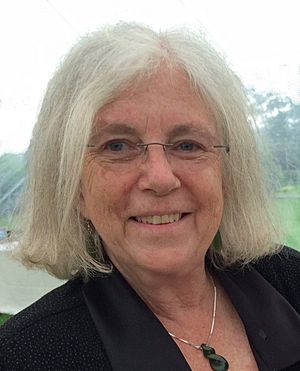Anne B. Young facts for kids
Quick facts for kids
Anne Buckingham Young
|
|
|---|---|
 |
|
| Born | |
| Alma mater | Vassar College, Johns Hopkins University School of Medicine |
| Known for | Neurodegenerative diseases, Huntington's disease, Glutamate |
| Spouse(s) | John B. Penney, Jr. (1971–1999), Stetson Ames (2005–present) |
| Scientific career | |
| Fields | Neuroscience |
| Institutions | University of Michigan, Harvard Medical School, Massachusetts General Hospital |
| Doctoral advisor | Solomon H. Snyder |
Anne Buckingham Young is an American physician and neuroscientist. She has made very important discoveries about brain diseases. She especially focused on problems that affect movement, like Huntington's disease and Parkinson's disease.
Dr. Young studied at Vassar College and then earned two degrees (MD and PhD) from Johns Hopkins Medical School. She taught at the University of Michigan and Harvard University. In 1991, she became the first female chief of neurology at Massachusetts General Hospital. She retired from this role in 2012. Dr. Young has won many awards. She is also the only person to have led both the international Society for Neuroscience and the American Neurological Association.
Contents
- Early Life and Family
- Amazing Discoveries
- Education and Career Path
- Selected Publications
- Colleagues
- Awards and Honors
Early Life and Family
Anne Young grew up in Evanston, Illinois, a town near Chicago. When she was young, her energetic personality earned her the nickname "Tiger Annie." Both of her parents were involved in science. Her father studied chemistry, and her mother studied physics.
After college, Young went to Johns Hopkins Medical School. There, she met her first husband, John (Jack) B. Penney Jr. They worked together professionally and had two daughters, Jessica and Ellen. Jack Penney passed away in 1999. Young is now married to her high school boyfriend, Stetson Ames.
Throughout her life, Dr. Young has had difficulty reading because of dyslexia. This challenge did not stop her from becoming a successful scientist and doctor.
Amazing Discoveries
Finding Out About Glutamate
Dr. Young's research career is full of important moments. In 1974, she helped discover that glutamate is a neurotransmitter. Neurotransmitters are like chemical messengers in the brain. They help brain cells talk to each other. Today, glutamate is known as the main exciting neurotransmitter in the human brain.
Understanding Brain Movement
In 1989, she co-wrote a paper that has been used by other scientists over 5000 times! This paper described how a part of the brain called the basal ganglia works. It helped explain how problems in this area can cause movement disorders like Huntington's and Parkinson's disease. Her work helped lead to treatments like deep brain stimulation for Parkinson's disease.
Studying Huntington's Disease
Dr. Young also worked with the Huntington Study Group. She wrote many reviews about the progress of research on Huntington's Disease. She helped create the Unified Huntington's Disease Rating Scale. This tool helps doctors and researchers measure how the disease affects people.
Education and Career Path
College Years
Anne Young went to Vassar College and earned a degree in chemistry. She also studied art history and philosophy. At college, she worked in a lab and became interested in how chemicals work in living things (biochemistry). She even helped develop a new way to test an enzyme called pyruvate decarboxylase.
Medical School and PhD
After Vassar, Young went to Johns Hopkins Medical School. She was one of only nine women in her class of 110 students. She finished her medical school courses very quickly. For her PhD, she worked with Professor Solomon H. Snyder. They studied potential neurotransmitters like glutamate. Her work was the first to suggest that glutamate was a key messenger in certain brain cells. She graduated with both her MD and PhD degrees in just five years!
Residency and Early Research
After Johns Hopkins, Dr. Young completed her internship and residency in neurology at the University of California San Francisco (UCSF). A residency is like a training program for doctors. After finishing their training, she and her husband, Jack, started working at the University of Michigan in 1978.
Research at University of Michigan
At the University of Michigan, Dr. Young and her husband set up the U of M Movement Disorders Clinic. They worked together on all their research. Dr. Young was the expert on brain chemicals and how they work. She focused on disorders that cause too much movement, like Huntington's disease. Her husband focused on disorders with too little movement, like Parkinson's.
They did groundbreaking research on the basal ganglia, a part of the brain important for movement. Their work helped explain how problems in this brain circuit cause movement disorders. This research was very important for developing new treatments.
The Venezuela Huntington's Disease Project
In 1981, Dr. Young joined Nancy Wexler on a trip to Lake Maracaibo, Venezuela. They went to study a large family with many members affected by Huntington's disease. Dr. Young and her husband returned every year with Wexler. They examined family members and collected DNA samples. This project helped James F. Gusella discover the location of the gene that causes Huntington's disease. Later, scientists found the exact gene and the change (mutation) that causes the disease. This led to genetic testing, which helps people know if they might develop Huntington's.
Leading at Massachusetts General Hospital
In 1991, Dr. Young was chosen to be the chief of neurology at Massachusetts General Hospital (MGH). This was a huge achievement because she was the first female chief in the hospital's 180-year history! She was also the first female chief of neurology at any teaching hospital in the United States.
Creating MIND
As chief, Dr. Young saw a great opportunity. She wanted to bring together all the labs at MGH that were studying brain diseases. She proposed turning an old Navy building into a new, open lab space. This idea got funding, and the Mass General Institute for Neurodegenerative Disease (MIND) was created. MIND helps researchers work together to find causes and treatments for brain diseases.
Teaching at Harvard Medical School
In 1991, Dr. Young also became a professor of neurology at Harvard Medical School. She continues to teach there today. Her research at Harvard has focused on how certain brain receptors are involved in diseases like Alzheimer's disease.
Leading National Organizations
Dr. Young has also held important leadership roles in major scientific organizations.
American Neurological Association
In 2001, she became the second woman to be president of the American Neurological Association. During her time as president, she helped create a program to mentor (guide) new neurologists and brain scientists. This program still helps young scientists today.
Society for Neuroscience
In 2003, Dr. Young was elected president of the Society for Neuroscience. This is a very large international organization for brain scientists. She oversaw the design and building of a new, environmentally friendly headquarters for the Society in Washington D.C.
Selected Publications
Over her many years of research, Dr. Young has contributed to over a hundred scientific papers. Most of her work focuses on brain diseases. Here are a few important examples:
- 1971: Nuclear localization of histamine in neonatal rat brain.
* This paper suggested that a chemical called histamine might be important for brain development in young animals.
- 1974: Glutamic Acid-Selective Depletion by Viral Induced Granule Cell Loss in Hamster Cerebellum
* This paper helped show that glutamate is a key chemical messenger in the brain.
- 1987: Glutamate Dysfunction in Alzheimers Disease- An Hypothesis
* After more studies, Dr. Young and her team suggested that problems with glutamate might play a role in Alzheimer's disease.
- 1989: The Functional Anatomy of Basal Ganglia Disorders
* This important paper described a model of how the basal ganglia works. It helped explain how problems in this brain area cause movement disorders like Huntington's and Parkinson's.
Colleagues
- John B. Penney Jr.
- Nancy Wexler
- James F. Gusella
- Sid Gilman
- Solomon H. Snyder
- Raymond D. Adams
- Ira Shoulson
Awards and Honors
Dr. Anne Young has received many awards for her important work:
- 1994: Chosen as a member of the Institute Of Medicine.
- 1995: Elected to the American Academy of Arts and Sciences.
- 1999: Received the Dean's Award for supporting women faculty at Harvard Medical School.
- 2001: Won the Marion Spencer Fay Award for excellence in medicine and science.
- 2005: Became a fellow of the Royal College of Physicians, England.
- 2006: Received the Milton Wexler Award from the Hereditary Disease Foundation.
- She has also received distinguished alumni awards from Johns Hopkins Medical School and Vassar College.
- She holds a special professor position at Harvard, called the Julieanne Dorn Distinguished Professor of Neurology.
|


